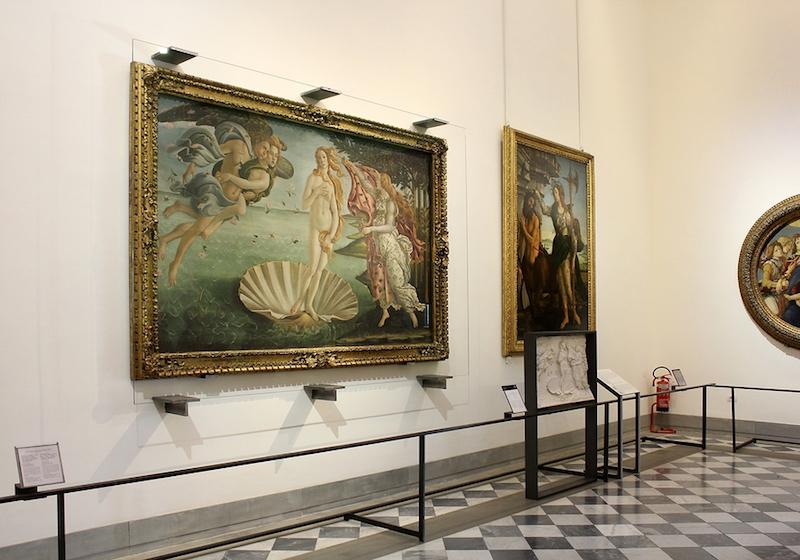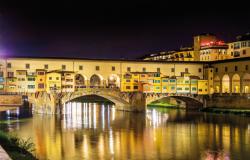Home to more UNESCO heritage sites than anywhere in the world, Italy has long attracted those who appreciate its rich cultural heritage, and who could blame them. Along with so many fabulous aspects, it is a country so deeply steeped in the arts. It’s safe to say you’ll find no better place than Florence for an artistic exploration of the highest caliber.
The thing is, many of us who live here know that we can jump in the queue at any given moment which leads to a lack of enjoying what’s right in front of us. I am totally guilty of this despite living less than 10 minutes from one of the world’s great museums. But lately, that’s about to change. I recently joined a tour with Ciao Florence, a local tour company that offers group excursions through the Uffizi Gallery with a knowledgeable guide.
A bit of information on the Uffizi itself, it wasn’t born into museum status straight away which would surprise many who aren’t from here. Instead it was formerly the offices, designed by Vasari, (which is what the term “Uffizi” literally means) of Cosimo Medici. He wasn’t just your average Florentine, he was the forefather of arguably the most important and influential families of the city, the powerful Medici’s. To start the tour, our guide pointed out the family crest (iconic for the arrangement of five or six balls) and busts of Cosimo, Lorenzo, Francis and Ferdinand the 1st on the second floor, before you enter the corridor itself.
Obviously a museum as popular as the Uffizi is frequented by many, it is estimated to be visited by over a million people per year. Going it on your own isn’t really recommended, as there are an overwhelming amount of artworks throughout the interesting u-shaped palace. Going with a guide allows you to get a deeper understanding of the art and the history of the artists themselves. Plus it's a lot more fun. When it comes to the Uffizi’s greatest works, you’ll find no shortage of masterpieces by great names such as Michelangelo, Caravaggio, Botticelli, Bronzino, Raphael, Leonardo and that’s only the beginning.

However, three artworks, all created before the 1500’s, carry a great importance to the understand of Italy’s art throughout history, one’s that not only take your breath away but also leave you wondering. Here are three that everyone should know about.
The Ognissanti Madonna – Giotto (1310)
This gothic painting was made for the Ognissanti church by artist Giotto di Bondone in Florence. Like the Ognissanti Madonna, many works were often painted on wood featuring gold backgrounds because gold was used to brighten up the often dark church. As was the fashion of the time, the theme represents the Virgin Madonna and a baby Jesus giving us the holy trinity salute. It’s important to note that most people couldn’t read the bible so instead “read” these paintings with biblical picture-stories at church. In this particular scene, the Virgin Mary and Jesus were naturally surrounded by angels - the scene before us is completely flat. This was the style of the time, though Giotto started to break the mold with this work by placing the angels in standing form on either side. You can also see the Madonna’s grasp on baby Jesus’s leg in a protective fashion, which in itself was a motherly gesture. This slight move to a more “natural” style moves ever forward to the style of the Renaissance.

Duke and Duchess of Urbino by Piero della Francesca (1465-1472)
To get a real understanding of Italian Renaissance at, one must-stop is the curious painting by Tuscan native Piero della Francesca, it depicts the duke Federico da Montefeltro and his wife Battista Sforza painted with tempura on wooden panels. Federico is credited to have made the town of Urbino in Italy’s Le Marche, one of the cultural centers of that time.
These two portraits feature only one side of their faces, Piero della Francesco cleverly hid the Duke’s missing right eye (apparently he lost It during a tournament) and a blemish on his nose. Apparently the concept of “my good side” was adopted as early as the 15th century. On the other side of the panels, you’ll see that the diptychs are also painted. On important note is to look at the positioning of their heads against the landscape. This is also meant to show power and status, they rise like towers in the sky over the countryside of Urbino.

This was created a depiction of a typical great Renaissance man making him eternal and enhancing their treasured status. The duchess appears to be very pale in the style of the time, we’re not sure if this was also a little extra whitening on the part of her makeup or the artist’s clever hand. She died an early death at the age of 26 due to childbirth, before the portrait was completed, which also helped to retain her memory.

Double portrait of the Dukes of Urbino, Photo credit. Wikimedia commons.
The Birth of Venus – Sandro Botticelli (1482-1485)
As a a “native” of Florence for the last 10 years, I am used to the glaze over people’s eyes when they tell me they’ve traveled thousands of miles to see Botticelli’s brilliance in person. There was recently a massive restoration in this area of the museum, enlarging and brightening the space to allow for more room around the works. Together with the Primavera, “The Birth of Venus” (completed 1482 and 1485) is one of the most well-known artworks of all time. It is as quintessentially Renaissance as they get and a must-see for ay visitor to Florence.
No longer were flat depictions the style of the time as was customary during the Medieval ages, instead there is much more movement and glory in the period known as the Renaissance from the 14th to the 17th centuries. And paintings on canvas was born. As we learned with the help of our guide Giannini, Botticelli’s Birth of Venus commissioned by Lorenzo di Pierfrancesco de’ Medici was born from Ovid’s Metamorphoses, a popular tale by the poet Homer. You can see Venus, born from the foam of the sea, shyly covering herself on a seashell as her handmade moves to cover her.

The technique for the time was remarkable, Venus almost seems to be carved out of marble, her every movement visible. Even if, as our guide pointed out, the seashell is incorrect in its size and perspective. Historically it marks the time when rich noble families such as the Medici’s were in the process of collecting and commissioning great, marking perhaps the most illustrious period in Florentine history.
 Curious for a deeper lesson in Florentine history and art? Join one of Ciao Florence’s Uffizi group tours, meeting daily at the Uffizi Gallery for an hour and a half of historical delight!
Curious for a deeper lesson in Florentine history and art? Join one of Ciao Florence’s Uffizi group tours, meeting daily at the Uffizi Gallery for an hour and a half of historical delight!




